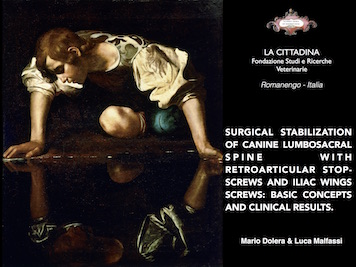SURGICAL STABILIZATION OF CANINE STABILIZATION OF CANINE LUMBOSACRAL SPINE WITH STOP-SCREWS AND ILIAC WINGS SCREWS
Surgical stabilization of canine lumbosacral spine can be challenging. The aim of this research was to evaluate two surgical techniques to achieve lumbosacral stabilization in dogs either with normal or transitional vertebrae. Lumbosacral instability and degenerative stenosis were evaluated by dynamic Computed Tomography (CT) and Magnetic Resonance Imaging (MRI). In dogs with normal vertebrae two 4.5 mm screws were bicortically inserted in S1 with the heads behind the caudal articular process of L7 to prevent the extension of the lumbosacral joint; if ventral listhesis of S1 was evident, the head of the screws were augmented by methyl methacrylate. In dogs with transitional vertebrae, two 4.5 mm screws were inserted in the iliac wings, two 3.5 mm screws were inserted in the spinous process of L6 and L7; the emerging screws were embedded in methyl methacrylate after flexion of the lombosacral spine. In cases of residual radicular compression, dorsal laminectomy and partial discectomy were accomplished. Serial clinical and imaging follow up examinations were performed. Twenty-two large breed dogs were enrolled. In 14 dogs stop-screws (in 4 augmented) and in 8 dogs iliac wings screws were inserted. 2 dogs required additional decompression. During a mean follow up of 36 months, clinical examination and imaging reveals amelioration of presenting complaints and reduction of radicular compression, with no surgical complications. Stop-screws and iliac wings technique are effective methods to obtain stabilization and indirect decompression of the lumbosacral joint. Comparing with other described surgical procedures, our obtained results are better but with lesser complications.
